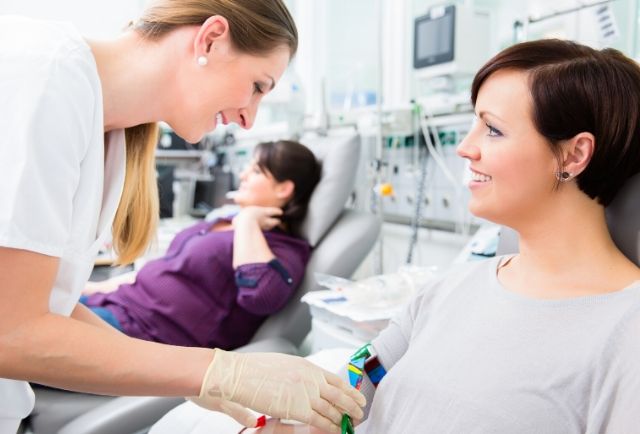The smart Trick of Northeast Medical Institute - New Haven Campus Phlebotomy Course & Cna Class That Nobody is Discussing
Table of ContentsThe Ultimate Guide To Northeast Medical Institute - New Haven Campus Phlebotomy Course & Cna ClassThe Only Guide to Northeast Medical Institute - New Haven Campus Phlebotomy Course & Cna ClassFacts About Northeast Medical Institute - New Haven Campus Phlebotomy Course & Cna Class UncoveredThe Buzz on Northeast Medical Institute - New Haven Campus Phlebotomy Course & Cna ClassThe Only Guide for Northeast Medical Institute - New Haven Campus Phlebotomy Course & Cna ClassNortheast Medical Institute - New Haven Campus Phlebotomy Course & Cna Class Can Be Fun For Anyone
The usage of such gadgets should be come with by various other infection avoidance and control techniques, and training in their use. Not all safety and security devices apply to phlebotomy. Prior to picking a safety-engineered tool, customers ought to thoroughly investigate offered tools to establish their proper usage, compatibility with existing phlebotomy methods, and effectiveness in securing staff and people (12, 33).For settings with reduced resources, price is a motoring consider purchase of safety-engineered devices - CNA Courses. Where safety-engineered tools are not available, experienced use a needle and syringe is appropriate. Unintentional exposure and certain information concerning an occurrence ought to be videotaped in a register. Support services need to be promoted for those who go through unexpected direct exposure.
Among the essential markers of top quality of care in phlebotomy is the involvement and cooperation of the client; this is mutually beneficial to both the wellness employee and the individual. Clear info either composed or spoken should be available to each client who goes through phlebotomy. Annex F offers example message for discussing the blood-sampling treatment to a person. labelling); transportation conditions; analysis of outcomes for clinical management. In an outpatient division or facility, provide a dedicated phlebotomy work area containing: a clean surface with 2 chairs (one for the phlebotomist and the other for the patient); a hand wash container with soap, running water and paper towels; alcohol hand rub. In the blood-sampling space for an outpatient department or facility, supply a comfy reclining couch with an arm remainder.
10 Simple Techniques For Northeast Medical Institute - New Haven Campus Phlebotomy Course & Cna Class
Make certain that the indicators for blood sampling are plainly specified, either in a composed method or in recorded directions (e.g. in a research laboratory form). Collect all the equipment required for the treatment and place it within safe and easy reach on a tray or trolley, making sure that all the things are clearly noticeable.
Present yourself to the client, and ask the individual to state their complete name. Inspect that the lab type matches the client's identity (i.e. match the patient's details with the lab type, to make sure precise recognition).
Make the client comfortable in a supine placement (if possible). The patient has a right to reject a test at any time before the blood tasting, so it is essential to make sure that the individual has actually understood the procedure - CNA Courses.
Examine This Report on Northeast Medical Institute - New Haven Campus Phlebotomy Course & Cna Class
Prolong the client's arm and examine the antecubital fossa or forearm. Situate a vein of a great dimension that is noticeable, straight and clear.
DO NOT place the needle where veins are diverting, because this raises the opportunity of a haematoma. The blood vessel needs to be visible without using the tourniquet. Situating the capillary will aid in determining the appropriate size of needle. Apply the tourniquet regarding 45 finger widths above the venepuncture site and re-examine the capillary.
Samplings from main lines lug a threat of contamination or incorrect research laboratory test results. It is acceptable, yet not perfect, to attract blood specimens when initial presenting an in-dwelling venous gadget, prior to attaching the cannula to the intravenous fluids.
4 Easy Facts About Northeast Medical Institute - New Haven Campus Phlebotomy Course & Cna Class Explained
Failure to enable adequate get in touch with time boosts the threat of contamination. DO NOT touch the cleaned site; in specific, DO NOT put a finger over the vein to assist the shaft of the revealed needle.
Ask the patient to form a hand so the veins are a lot more noticeable. Get in the capillary quickly at a 30 level angle or much less, and remain to present the needle along the capillary at the most convenient angle of access - PCT Training. Once adequate blood has been accumulated, release the tourniquet BEFORE taking out the needle
The 2-Minute Rule for Northeast Medical Institute - New Haven Campus Phlebotomy Course & Cna Class
Take out the needle gently and use mild pressure to the site with a clean gauze or completely dry cotton-wool sphere. Ask the patient to hold the gauze or cotton woollen in Click Here place, with the arm prolonged and elevated. Ask the patient NOT to flex the arm, due to the fact that doing so causes a haematoma.

Top Guidelines Of Northeast Medical Institute - New Haven Campus Phlebotomy Course & Cna Class
Do not push the syringe plunger because added stress boosts the risk of haemolysis. Where possible, keep the tubes in a shelf and relocate the shelf in the direction of you. Infuse downwards into the proper coloured stopper. DO NOT eliminate the stopper since it will launch the vacuum. If the sample tube does not have a rubber stopper, infuse extremely slowly into the tube as decreasing the pressure and speed made use of to transfer the specimen reduces the danger of haemolysis.
